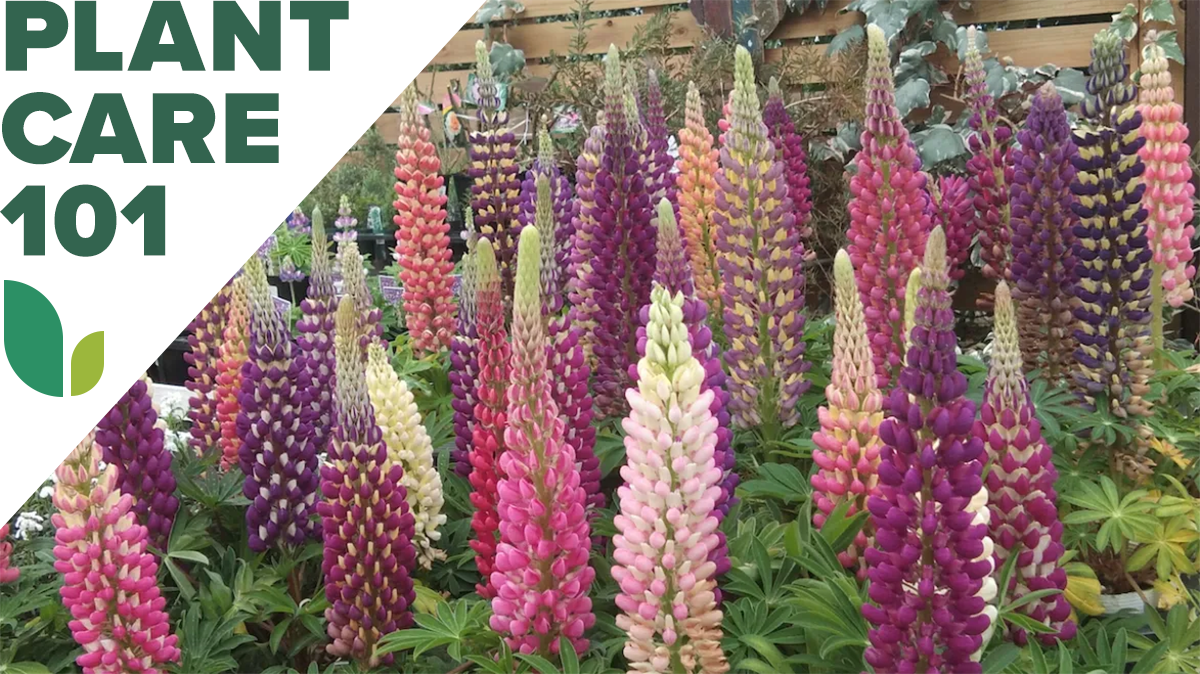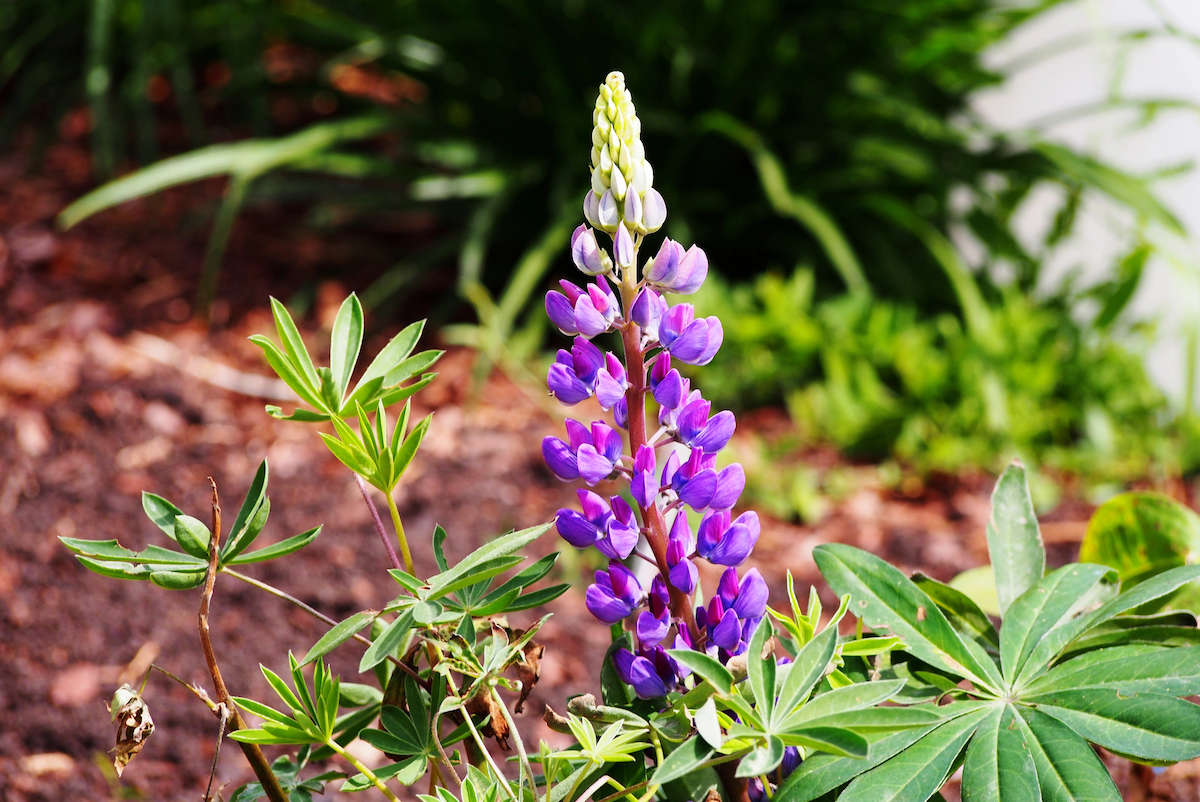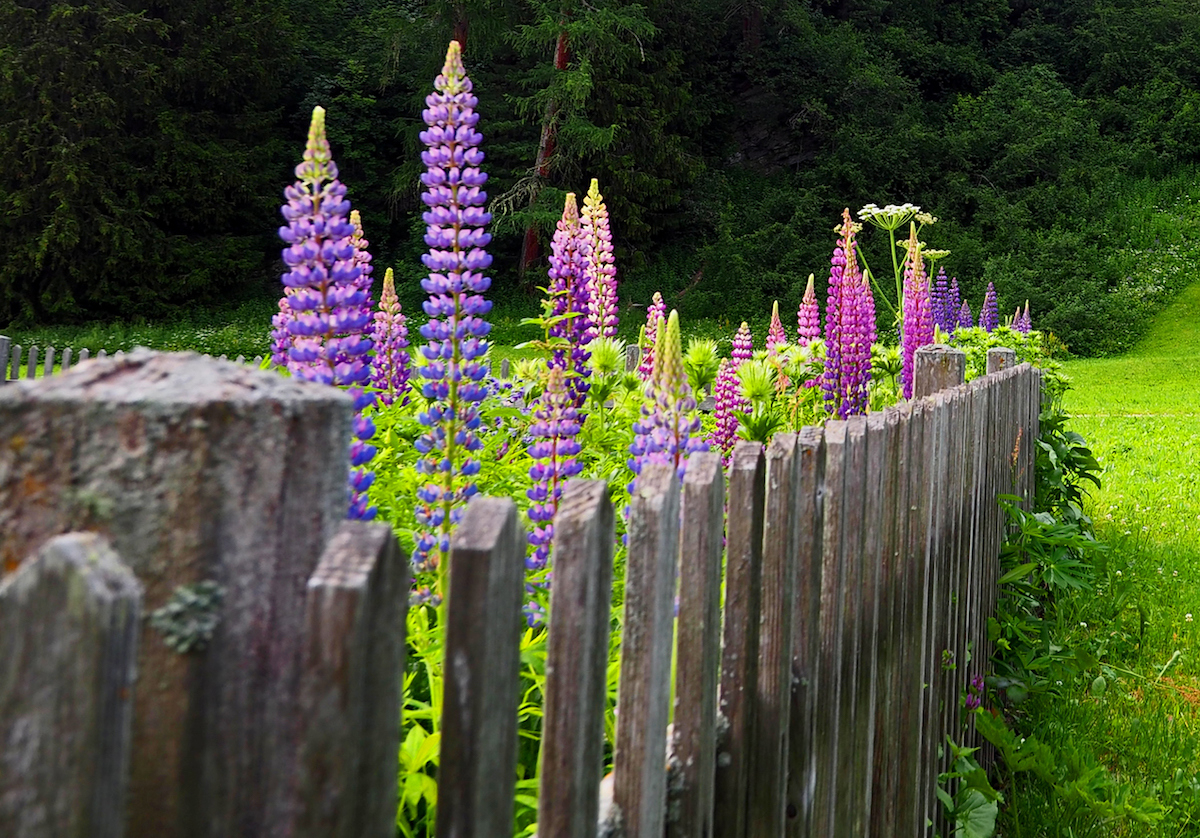

We may earn revenue from the products available on this page and participate in affiliate programs. Learn More ›
Each spring, tall, lush spires of brightly colored lupine blooms appear and last through the summer, feeding wildlife and endearing passersby across North America. Whether they’re annual species like bluebonnets or perennials , lupine grows best where summers are cool. In addition to its human admirers, the lupine plant attracts pollinators to its tubular flowers of white, pink, red, yellow, blue, or purple.
Most lupine varieties sold today are hybrids of the wild lupine plant. A fast-growing legume in the pea family, this North American native is a nitrogen fixer that improves the soil. Given the right conditions, proper soil, and correct amount of moisture, lupine plant care is rather easy.
Lupine Care at a Glance

Common Name: Lupine
Scientific Name: Lupinus
Soil: Moist, sandy, acidic
Light: Full sun
Water: Prefers moist soil, but drought tolerant
Food: Little to no fertilizer; avoid nitrogen
Temperature and Humidity: Cooler spring/summer temperatures, moderate humidity
Propagation: Seeds or cuttings
Safety: Toxic to animals and humans
Lupine Characteristics
Lupine plants grow up to 4 feet tall, with a spread of up to 3 feet, and they’re characterized by their small flowers aligned on tall, erect spires. Lupine bloom time lasts from spring to midsummer, adding large splashes of native wildflower color to meadows and fields each year—and they also make stunning garden plants and cut flowers. In the South, a lupine commonly known as the Texas bluebonnet creates a carpet of color when it blooms.
Lupine seeds emerge from flat, hairy, peapod-like seed pods and will often self-sow.
Types of Lupines

With more than 300 existing species, there are plenty of varieties from which to choose. Decide if you want lupine perennials or annuals and determine which types grow best in your conditions.
- Lupinus polyphyllus: Also called garden lupine, bifleaf lupine, or Russell hybrid lupine, this is the perennial wildflower from which new hybrids are created. This blue or purple lupine can take a year to bloom and, although it’s native to the West, it’s considered invasive in some parts of North America.
- Lupinus perennis: This wild perennial blue lupine, also known as sundial lupine, grows across the East through the Midwest.
- Lupinus texensis: Also known as the Texas bluebonnet, this annual lupine features vibrant indigo flowers with white or yellow petals. They are adapted to the harsher climate of the South, preferring full sun and well-drained (even poor, rocky) soil.
- Lupinus albifrons: The silver lupine is a taller variety that grows 3 to 5 feet tall, featuring pale blue-to-purple flowers atop its silver-green leaves.
- Lupinus albus: According to the National Library of Medicine, the white lupin is being studied for the ability of its high level of protein to lower blood glucose and improve insulin sensitivity.
- Lupinus angustifolius: Sometimes called narrowleaf lupine, this is another tall variety that grows to up 5 feet tall. Despite its pretty blue blooms, it is more popularly grown for agriculture than in gardens.
Selecting Soil for Lupines
The secret to how to grow lupine plants lies in the soil. They prefer organically rich or loose, sandy, well-draining soil that has a neutral to slightly acidic pH, although they can live in very acidic soil. They don’t tolerate heavy soils or clay soil unless heavily amended with compost, and they do not like wet conditions.
Soil lacking phosphorus will result in fewer blooms. Because lupines prefer cool temperatures and cool soil, a layer of mulch can help the soil retain moisture, keeping the lupine’s roots chilled.
Because they are a legume with a large taproot, they not only help break up heavy garden soil but can also convert atmospheric nitrogen into a form accessible to plants.
The Right Light

Full sun will keep the lovely lupine healthy, happy, and blooming. They should receive 6 to 8 hours of direct sun every day. Growing them in open fields, as the wild varieties do, ensures they will receive adequate amounts of sunlight. If planted in flower beds, trimming overhanging branches and nearby shrubs helps ensure they’ll get the sunlight they need.
Although lupines can survive in partial shade (4 to 6 hours of sun per day), they won’t produce as many flowers. However, if grown in hot Southern climates, they may benefit from some light afternoon shade.
Watering Lupines
Lupines enjoy regular watering. If they don’t receive ample rainfall to keep the soil moist, it’s wise to water them weekly. Moderate water is enough; the soil should dry out between waterings. Lupines do not like waterlogged soil, which can open the door to disease.
Although perennial lupines are drought tolerant once established and rarely need extra watering, they may benefit from being watered during dry weather. Underwatering can reduce the number of blooms.
Plants should be watered at the base rather than from overhead to minimize the amount of water that stays on the foliage for an extended period of time.
Fertilizing Lupines
Wild lupines tend to grow in areas with low soil fertility, so it’s no surprise that lupines need little to no fertilizer. In fact, too much fertilizer triggers foliage growth at the expense of flowers. However, adding an acidifying, phosphorous-heavy fertilizer can benefit lupine planting by lowering the pH of alkaline soils.
Lupines can benefit from a layer of compost applied in the spring. Not only does it provide nutrients, but it also helps keep the plant’s roots cool.
Setting the Temperature and Humidity

Cool spring and summer temperatures offer the best growing conditions for lupines, which don’t bloom as well in the hot, humid climate of the southern U.S. To help them overcome the heat of summer afternoons in warmer climates, lupines can be planted in areas that receive afternoon shade, although don’t expect as many blooms with less sunlight. They should be treated as a hardy annual in warmer climates, meaning they can be sown in the fall and overwintered.
Typically grown in USDA Hardiness Zones 4 to 8, lupines will die back after a frost, at which time you’ll want to cut back their stalks and cover plants with a protective layer of mulch.
Propagating Lupines
Although lupines can be propagated by basal cuttings or division, growing lupine from seed is the most common method because it’s easy. However, lupines grown from seed don’t usually flower until the second year.
Knowing how to germinate lupine seeds starts with nicking the tough seed coat or soaking seeds overnight and includes knowing when to plant lupine seeds. The best time is late spring or fall for direct sowing because lupine seedlings do not transplant easily.
For basal cuttings, wait until new growth from the crown has reached at least 6 inches long before taking a cutting. Cut off at least half of the leaf and place in a sterile, loose potting mixture kept between 60 and 65 degrees Fahrenheit.
Division is a last resort for propagation because lupines don’t like having their roots disturbed, but if you opt for this method, wait until after the plants have bloomed. Divide the fleshy crown so that there are at least three growth buds on each division.
Safety Considerations

Lupine plants are not poisonous to the touch and do not cause contact dermatitis; however, lupines do have a low severity level of toxicity to humans and animals if consumed, according to North Carolina State University Extension although typically, they are toxic only if large quantities are eaten. Symptoms include respiratory depression, slow heartbeat, sleepiness, and convulsions.
Some varieties can be poisonous to cattle and sheep, resulting in blindness, convulsions, and heavy or labored breathing. Lupines can cause “crooked calf” disease if eaten between forty and seventy days of gestation, resulting in deformities and twisted limbs in calves. For this reason, wild lupines are considered harmful weeds in some regions of the US.
Potential Pests and Diseases
Diseases include anthracnose, blight, brown spot, leaf spot, powdery mildew, root and crown rot, rust, wilt, and various viruses. Fungal disease commonly occurs if they’re propagated by cuttings. Anthracnose causes root rot and leads to wilting and death of the plant. It occurs in cool, moist conditions and is particularly hard on young plants. Remove and destroy the affected plants and avoid growing lupines in that spot for several years to give the spores time to die off. Powdery mildew occurs after overhead watering and poor air circulation, especially if plants are crowded.
Common pests include aphids, slugs, snails, and thrips. Lupines are particularly vulnerable to aphids in the spring. Horticultural oils or pesticides are usually effective. Despite being a wildflower, however, many lupine varieties can be grown as deer-resistant garden plants.
FAQ About Lupine Care
Increase the amount of light, make sure they’re getting enough water, check to see if the soil has enough phosphorus, and deadhead.
Flowers that bloom in late spring or early summer and that like acidic soil make good companions. Try tulips, Shasta daisies, allium, daffodils, and California poppies.
Most varieties are considered short-lived perennials, which means they’ll have 2 to 3 years of robust growth. However, they self-sow and can continue producing new plants.
